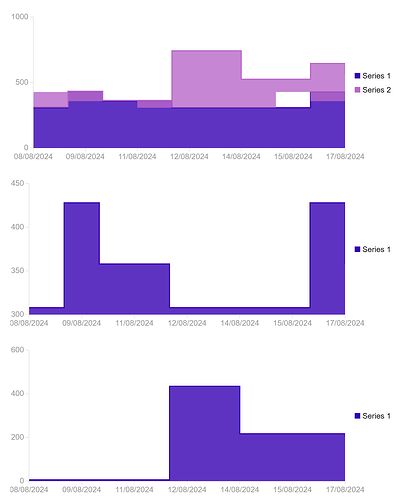The chart at the top is what I'm seeing, with overlaps and random gaps. Below that are two charts using the same data separated into two series:
Here's the code:
@page "/"
@using System.Globalization
@using System.Text.Json
@if (GroupedAccounts != null)
{
<RadzenChart>
@foreach (var Account in GroupedAccounts)
{
<RadzenStackedAreaSeries Interpolation="Interpolation.Step" Data="@Account" CategoryProperty="Date" ValueProperty="Balance" TItem="DataModel" />
}
</RadzenChart>
<RadzenChart>
<RadzenStackedAreaSeries Interpolation="Interpolation.Step" Data="@Account1" CategoryProperty="Date" ValueProperty="Balance" TItem="DataModel" />
</RadzenChart>
<RadzenChart>
<RadzenStackedAreaSeries Interpolation="Interpolation.Step" Data="@Account2" CategoryProperty="Date" ValueProperty="Balance" TItem="DataModel" />
</RadzenChart>
}
@code {
private List<List<DataModel>>? GroupedAccounts { get; set; }
private List<DataModel>? Account1 { get; set; }
private List<DataModel>? Account2 { get; set; }
protected override void OnInitialized() => DeserializeJson();
public void DeserializeJson()
{
string json = @"
[
[
{
""Date"": ""2024-08-08T00:00:00+01:00"",
""Balance"": 307.98
},
{
""Date"": ""2024-08-09T00:00:00+01:00"",
""Balance"": 427.98
},
{
""Date"": ""2024-08-10T00:00:00+01:00"",
""Balance"": 357.98
},
{
""Date"": ""2024-08-11T00:00:00+01:00"",
""Balance"": 357.98
},
{
""Date"": ""2024-08-12T00:00:00+01:00"",
""Balance"": 307.98
},
{
""Date"": ""2024-08-13T00:00:00+01:00"",
""Balance"": 307.98
},
{
""Date"": ""2024-08-14T00:00:00+01:00"",
""Balance"": 307.98
},
{
""Date"": ""2024-08-15T00:00:00+01:00"",
""Balance"": 307.98
},
{
""Date"": ""2024-08-16T00:00:00+01:00"",
""Balance"": 427.98
},
{
""Date"": ""2024-08-17T00:00:00+01:00"",
""Balance"": 357.98
}
],
[
{
""Date"": ""2024-08-08T00:00:00+01:00"",
""Balance"": 5.90
},
{
""Date"": ""2024-08-09T00:00:00+01:00"",
""Balance"": 5.90
},
{
""Date"": ""2024-08-10T00:00:00+01:00"",
""Balance"": 5.90
},
{
""Date"": ""2024-08-11T00:00:00+01:00"",
""Balance"": 5.90
},
{
""Date"": ""2024-08-12T00:00:00+01:00"",
""Balance"": 434.18
},
{
""Date"": ""2024-08-13T00:00:00+01:00"",
""Balance"": 434.18
},
{
""Date"": ""2024-08-14T00:00:00+01:00"",
""Balance"": 217.16
},
{
""Date"": ""2024-08-15T00:00:00+01:00"",
""Balance"": 217.16
},
{
""Date"": ""2024-08-16T00:00:00+01:00"",
""Balance"": 217.16
},
{
""Date"": ""2024-08-17T00:00:00+01:00"",
""Balance"": 203.91
}
]
]";
GroupedAccounts = JsonSerializer.Deserialize<List<List<DataModel>>>(json);
if (GroupedAccounts != null)
{
Account1 = GroupedAccounts[0];
Account2 = GroupedAccounts[1];
StateHasChanged();
}
}
public class DataModel
{
public required DateTime Date { get; set; }
public decimal Balance { get; set; }
}
}
What's happening here?


